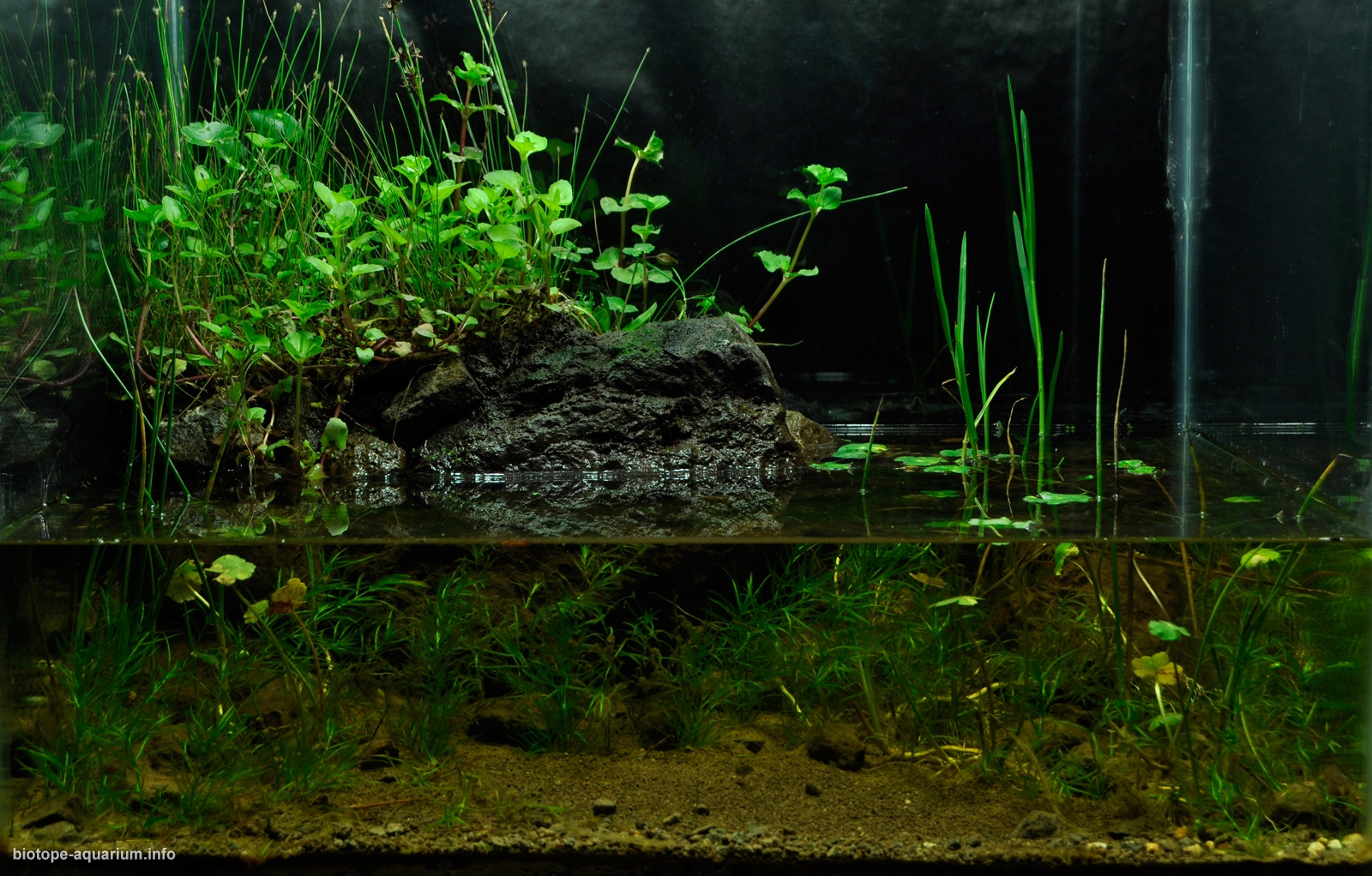Valley of Silence: A refuge for Mexcalpique (Girardinichthys sp.). Ocoyoacac, State of Mexico, Mexico
46th place in Biotope Aquarium Design Contest 2017
![]() Mexico. Amadeo Hernández Pérez
Mexico. Amadeo Hernández Pérez

Volume: 165 L
Dimensions: 60x55x50 cm
List of fishes: Girardinichthys sp. and Cambarellus montezumae
List of plants: Eleocharis sp., Hydrocotyle sp., Juncus sp., Mimulus sp., Naja guadalupensis and Pennisetum clandestinum.
Description of decorations and substrate: Plants are used that can be found in the biotope created (mainly Naja guadalupensisand Hydrocotyle sp.) as well as stones and substrate collected from the natural environment.
Description of equipment: Internal filter AquaJet300 (300 lph), fluorescent bulbs 2x32w, 6500°K; Photoperiod: 8 hours of daily lighting with influence of sunlight for 2 hours a day and thermostat is not used for temperature.
Water parameters: The physicochemical characteristics of water (Aquarium biotope): Dissolved oxygen: 4.3 mg/L, Percentage of oxygen saturation: 66.78, Ammoniacal nitrogen (N-NH3): 0.02 mg/L, Nitrite: 0.01 mg/L, Nitrate (NO3ˉ): 0.03 mg/L, pH: 7.4, Temperature: 16 ° C and SST: 6 mg/L.
Description of the area surrounding the biotope: The Valley of Silence, is located at the national park Miguel Hidalgo and Costilla, better known as La Marquesa, in the municipality of Ocoyoacac, State of Mexico; Mexico. La Marquesa is located in the Central Plateau of Mexico, one of the largest mountain systems in the world that is considered by the Word Conservation Monitoring Center as one of the most important regions in the world for the conservation of fish freshwater as the main freshwater wetlands in the country with a unique fish diversity (Domínguez- Domínguez and Pérez-Ponce de León, 2007), in which goodeids are one of the most representative groups (Domínguez-Domínguez et al., 2006).
Description of the underwater landscape of the biotope: The marginal part of the body of water is not greater than 30 cm, thanks to the crystalline water, it is easy to appreciate the beauty of the biotope as well as its biotic components (aquatic flora and fauna) and abiotic (substrate, stones). The substrate is formed by small stones (0.2 to 1.0 cm) and earth that to any aggressive movement returns the turbid water, which seconds will become crystal clear again. On the shore you can find large stones that together with the marginal plants provide an excellent shelter for Mexcalpique.
Description of the parameters of the habitat: The physicochemical characteristics of water (Natural medium): Dissolved oxygen: 4.3 mg/L, Percentage of oxygen saturation: 66.78, Ammoniacal nitrogen (N-NH3): 0.04 mg/L, Nitrite: 0.03 mg/L, Nitrate (NO3ˉ): 0.04 mg/L, pH: 7.2, Temperature: 13.8 °C and SST: 12 mg/L.
List of fishes: Girardinichthys sp., Cambarellus montezumae, Gammarus sp., frog of the genusLithobates and two exotic species introduced for sport fishing Oncorhynchus mickiss and Cyprinus carpio
List of plants: The Valley of Silence is surrounded mainly by coniferous forest (mainly Pinnus, Abies, Cupressus and Juniperus) and high mountain pastures. In this body of water we can find Naja guadalupensis, Hydrocotyle sp., Eleocharis sp., Mimulus sp., Juncus sp., Poa annua, Pennisetum clandestinum and some Bryophytes.
Threats to the ecology: Like most of the aquatic fauna that lives in bodies of water of the center of Mexico, this family is in serious risk of disappearing, in fact it’s considered like one of the groups of fish with greater risk of extinction in the world since the Lerma hydrological system represents one of the largest volumes of water extraction in the country, both groundwater and surface water; at the same time, its watershed is one of the most important sectors of economy in the country with a large number of industries and agricultural areas on its margins, making it one of the most polluted and impacted basins in the world (Domínguez-Domínguez and Pérez-Ponce de León, 2007). Ironically this river is one of the most important for the ichthyological diversity of the country, is home of the largest number of species of Goodeids (16 species) and has one of the highest rates of endemism of fish, which globally reaches 66%. Unfortunately, in some cases the environmental impact is such, that some species of Goodeids have been reported extinct, such as Characodon garmani and Skiffia francesae, although the lasts ones are still kept in captivity, another is considered as possibly extinct or on the verge of extinction (Zoogoneticus tequila) and several with a high risk (such as Ameca splendens, Allotoca goslinae, Allotoca maculata and Allodontichthys polylepis). The last five are inhabitants of the Ameca River basin in the state of Jalisco, where water contamination by agricultural fertilizers, desiccation, introduction of exotic species and habitat fragmentation by the construction of reservoirs are the main causes of deterioration (Domínguez-Domínguez and Pérez-Ponce de León, 2007). In this biotope aquarium is attempted to recreate the marginal zone of the Valley of Silence lagoon in which you can find a locally known godeido Mexcalpique (Girardinichthys sp.), Endemic fish of Mexico with endangered species categoryaccording to IUCN and NOM-059-SEMARNAT-2010. The crystalline water of the lagoon allows us to appreciate active swimming, generally with greater nutritional activity and reproductive courtship in the shallow areas, finding shelter in the patches of aquatic plants (Naja guadalupensis and Hydrochotyle sp.), we can also find the crustacean locally known as acocil (Cambarellus montezumae) and two exotic species introduced for sport fishing (Oncorhynchus mickiss and Cyprinus carpio) which have a negative effect since being exotic species 1) are predatory, 2)compete for food resources and 3) alter the ecological niche and can displace the species local.
Sources of information:
- Domínguez-Domínguez, O., G, Pérez Ponce de León. (2007). Los godeidos, peces endémicos del centro de México. CONABIO. Biodiversistas 75: 12-15.
- Navarrete-Salgado, Norma A.; Rojas-Bustamante, Margarita L.; Contreras-Rivero, Gilberto; Elías Fernández, Guillermo. (2007). Alimentación de Girardinichthys multiradiatus (Pisces: Goodeidae) en el embalse La Goleta, Estado de México. Ciencia Ergo Sum, vol. 14, núm. 1, marzo-junio, 2007, pp. 63-68 Universidad Autónoma del Estado de México; Toluca, México.
- Navarrete- Salgado, N. A., Cedillo-Díaz, B. E., Contreras-Rivero, G. y Elias-Fernandez, G. (2007). Crecimiento, reproducción y supervivencias de Girardinichthys multiradiatus (Pisces, Goodeidae) en el embalse San Miguel Arco, Estado de México. Revista Chapingo Serie Ciencias Forestales y del Ambiente 13(a): 15-21, 2007.
Comments of the members of the jury of Biotope Aquarium Design Contest 2017

This is a tiny but highly compelling biotope representing an endangered habitat. Delicate and unusual aquatic plants create a miniature fairytale forest populated by the dwarf crayfish Cambarellus montezumae and diminutive Giardinichthys. It is an entire world for these miniscule creatures, and the crayfish are behaving just as they would in the wild – excavating, sifting the sand, fending off rivals, and breeding – oblivious to observers. Meanwhile the tiny Giardinichthys hover and search for prey between the feathery fronds of aquatic plants. Emersed grasses and other plants hang over the surface, providing cover. Although small, the scene exudes a feeling of verdant abundance and life.
